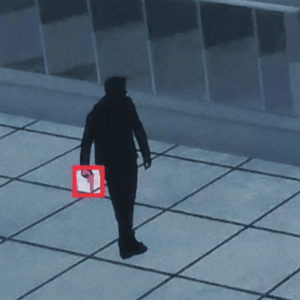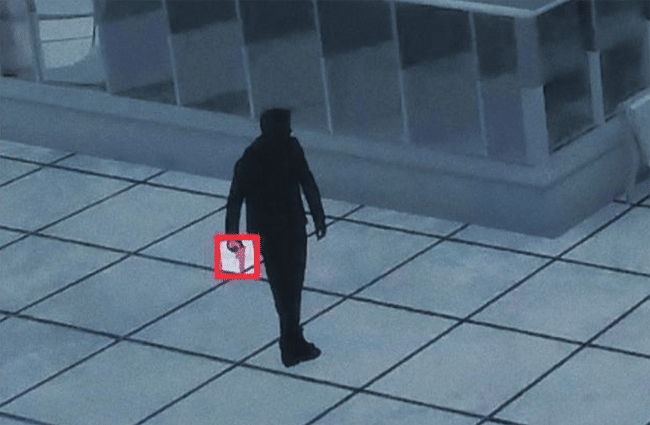From Identifying Threats in the Sky to Detecting Firearms on the Ground, ZeroEyes Expands Drone Capabilities for Law Enforcement and Defense
by DRONELIFE Features Editor Jim Magil
ZeroEyes develops drone-detection technology, UAV-based gun detection
By Jim Magill
Drones are tools that can be used for both good and bad purposes. In the right hands, they can be used to inspect roads and bridges, deliver groceries and medicines, and help provide first responders with the eyes in the sky needed to detect hot spots in a fire or help secure a crime scene. In the wrong hands, they can be used to surreptitiously observe unsuspecting people, drop contraband into a prison yard or disrupt a sporting event.
ZeroEyes, a software and data analytics security company, is leveraging its technology to add to the positive powers of UAVs, while also enhancing detection techniques to address the growing problem of drones piloted by malicious or careless actors. Based in Conshohocken, Pennsylvania, ZeroEyes was founded by former Navy Seals as a defense-oriented technology company.

 Through its subsidiary, ZeroEyes Government Solutions, the company is looking at drones in two ways: developing technology to find and identify drones that may be presenting a security risk, as well as using drones as platforms on which to mount the company’s gun-detection equipment.
Through its subsidiary, ZeroEyes Government Solutions, the company is looking at drones in two ways: developing technology to find and identify drones that may be presenting a security risk, as well as using drones as platforms on which to mount the company’s gun-detection equipment.
“Trying to prevent drones from where they shouldn’t be is a big problem right now, and not just in the U.S.,” Dustin Kisling, ZeroEyes senior vice president, said in a series of interviews.
He said ZeroEyes, which uses artificial intelligence (AI) technology to implement gun-detection services for law enforcement agencies, also has developed drone-detection technology, which it plans to market to U.S. defense agencies and other potential customers.
Kisling, who heads up ZeroEyes Government Solutions, said the company’s drone-detection capabilities are a direct outgrowth of ZeroEyes’ work to make schools and other public spaces safer by being able to spot the presence of a gun, and alert authorities in close to real time.
He said the company plans to roll out its drone-detection technology first to its defense industry customers and eventually to civilian law enforcement agencies and other security-minded users.
“I think globally you see that drones are becoming a larger problem set with the military,” he said. “So, I think there’s going to be a much stronger focus on this for governments, for [Department of Defense] and for law enforcement moving forward.”
Unwanted drone incursions increasingly are presenting potential threats at many governmental and civilian facilities, such as sporting venues, military installations, schools and prisons. Kisling said that dealing with these facilities’ vulnerabilities to drone incursions is going to take some creative solutions.
“This fits really well within our wheelhouse,” he said. “Physical detections based on object recognition, is what we do, and we do it really well.”
The methodology that the company employs to detect guns can be applied to detecting and identifying drones, which can appear as small objects in the sky to the naked eye.
“There’re a couple ways we can do it. With the camera, we can do visible detections of drones, Kisling said. “We can then send that information to someone on the ground who can get it and then shift their resources specifically to that drone.”
Another way in which the company’s technology can be used to detect drones is by employing a radar signature to conduct a broad scan of the sky. “Once that radar signature detects the anomaly then you can slew a visual spectrum camera over to it, and then we can start running the analytics off of the radar signature.”
Once the drone is detected, ZeroEyes can apply its visual analytics to get a picture of it, which can be sent to the customer, whether a government agency or a civilian entity.
The other aspect of ZeroEyes two-pronged approach to drone security involves the use of drones as aerial platforms for the company’s gun-detection technology. The company can use the drones’ cameras in much the same way that it currently uses static cameras placed at fixed locations. Using that system, ZeroEyes’ software analyzes more than three billion images a day from security camera video feeds. If a firearm is detected, ZeroEyes can connect to the facility’s existing security cameras and monitor streaming video feeds to further detect guns.
Whenever a firearm is detected an image appears on the operator’s screen with a green box around what the A.I. system identifies as a gun.
In less than a second, the operator enhances the image to verify whether or not the image actually identifies a gun. Once the image is positively identified as a firearm, the operator presses the dispatch button, triggering the appropriate response from security or law enforcement personnel.
Using drones as a platform for ZeroEyes’ gun-detection software would provide a higher altitude vantage point, allowing views of rooftops and other areas not accessible to fixed-place cameras.
“Rather than having a stationary camera that you mount on the exterior of the building and it’s fixed there, now you can have drones that are flying,” Kisling said. “Whether they’re tethered or untethered, drones that are doing a scan can extend the perimeter because those drones have eyes on areas where people can’t normally see.”
Kisling said a number of potential customers have expressed an interest in the company’s drone-borne gun-detection technology.
“I think there’re a lot of government agencies that are looking at counter-drone technology,” he said. “A lot of customers have asked about using drones for a response type thing.” Among the potential users of the technology are numerous federal and state-level agencies, as well as some non-governmental groups.
“Enhancing the capabilities of drones to better support the end-users on the ground in their mission set is going to be a big focus in the years going forward,” Kisling said. He noted that many local police departments and sheriff’s offices that have established UAV programs are looking for additional ways to employ their drone assets to enhance the security of the areas under their jurisdiction.
“I think a big focus now is how do you take these existing platforms and give them a more proactive detection capability, like spotting guns where they shouldn’t be.”
Want DRONELIFE news delivered to your inbox every weekday? Sign up here.
Read more:

 Jim Magill is a Houston-based writer with almost a quarter-century of experience covering technical and economic developments in the oil and gas industry. After retiring in December 2019 as a senior editor with S&P Global Platts, Jim began writing about emerging technologies, such as artificial intelligence, robots and drones, and the ways in which they’re contributing to our society. In addition to DroneLife, Jim is a contributor to Forbes.com and his work has appeared in the Houston Chronicle, U.S. News & World Report, and Unmanned Systems, a publication of the Association for Unmanned Vehicle Systems International.
Jim Magill is a Houston-based writer with almost a quarter-century of experience covering technical and economic developments in the oil and gas industry. After retiring in December 2019 as a senior editor with S&P Global Platts, Jim began writing about emerging technologies, such as artificial intelligence, robots and drones, and the ways in which they’re contributing to our society. In addition to DroneLife, Jim is a contributor to Forbes.com and his work has appeared in the Houston Chronicle, U.S. News & World Report, and Unmanned Systems, a publication of the Association for Unmanned Vehicle Systems International.
Miriam McNabb is the Editor-in-Chief of DRONELIFE and CEO of JobForDrones, a professional drone services marketplace, and a fascinated observer of the emerging drone industry and the regulatory environment for drones. Miriam has penned over 3,000 articles focused on the commercial drone space and is an international speaker and recognized figure in the industry. Miriam has a degree from the University of Chicago and over 20 years of experience in high tech sales and marketing for new technologies.
For drone industry consulting or writing, Email Miriam.
TWITTER:@spaldingbarker
Subscribe to DroneLife here.


